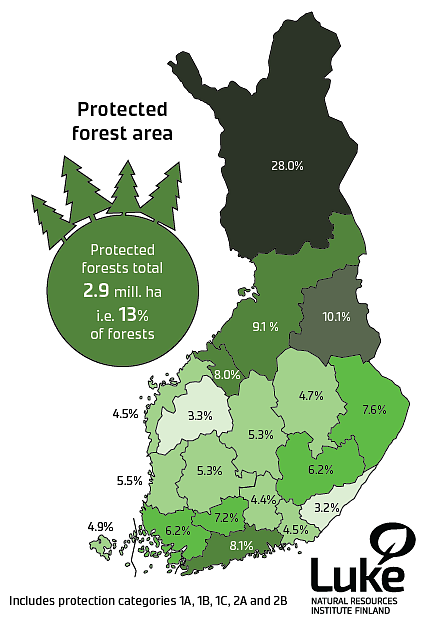Protected forest area has increased
According to the Natural Resources Institute Finland’s (Luke) recent forest protection statistics, the area of Finland’s protected forests has increased by a total of 57,000 hectares in statutory protected areas and at biodiversity conservation sites in commercial forests during the last three years. At the beginning of 2022, protected forests continued to account for 13 per cent of Finland’s forest area.
“The forest protection statistics reflect the development of the area of statutory protected areas and biodiversity conservation sites in commercial forests. On 1 January 2022, a total of 2.94 million hectares of Finnish forests were protected. Of this, productive forest land accounted for 1.70 million and poorly productive forest land 1.24 million hectares. In total, 13 per cent of Finland’s forest area was protected,” says Tuomas Niinistö, senior statistician at Luke.
The majority of Finland’s protected forests fall wholly outside the scope of forestry measures. These forests are located at nature conservation sites established under the Nature Conservation Act, in areas designated to be established as nature conservation sites in conservation programmes, and in wilderness areas. At the beginning of 2022, protected forests falling wholly outside the scope of forestry measures covered 2.27 million hectares, accounting for ten per cent of Finland’s forest area. Of this, forest land made up 54 per cent and poorly productive forest land 46 per cent.

Forest protection focused on Northern Finland
Northern Finland – the regions of Lapland, Northern Ostrobothnia and Kainuu – accounted for three quarters, or 2.29 million hectares, of protected forests. This means that a fifth of all forests in Northern Finland are protected. The areas of protected productive forest land and poorly productive forest land were roughly identical in Northern Finland. Of these, 1.89 million hectares fell wholly outside the scope of forestry measures.
In Southern Finland, six per cent, or 0.65 million hectares, of forests were protected. Of these, 0.38 million hectares were wholly outside the scope of forestry measures. In the south, productive forest land accounted for 84 per cent of the protected forest area, a significantly larger part than in the north.
“Of all protected forests, more than four fifths are located on state-owned land. The state mainly owns forests in Northern Finland. The significance of conservation sites in non-industrial private forests increases when moving towards the south where non-industrial private forests are mainly owned,” Niinistö says.

Protected forest area has increased
The previous forest protection statistics covered the situation as of 1 January 2019. Since then, the area of statutory protected areas has increased by 41,000 hectares and that of biodiversity conservation sites in commercial forests by 16,000 hectares.
The protected forest area has increased by 25,000 hectares in Northern Finland and 32,000 hectares in Southern Finland. The percentage of the protected forest area has remained unchanged at 20 per cent in Northern Finland, while it has increased by one percentage point to six per cent in Southern Finland.
Information about the statistics
Luke compiles forest protection statistics every three years, and the statistics reflect the protection situation at the beginning of the statistical year. In these statistics, forests mean the total area of forest land and poorly productive forest land in accordance with Finland’s national definition of forests. The difference between forest land and poorly productive forest land is the tree growth rate, which is lower in poorly productive forest land. Combined, these constitute the total area covered with trees, i.e. forests.
The forest area in accordance with the Finnish definition is very close to the national forest area defined by the Food and Agriculture Organization (FAO) of the United Nations and used in international statistics. In Finland, the total area of forest land and poorly productive forest land is roughly 1.7 per cent higher than the forest area based on the FAO’s definition. International protection statistics apply the FAO’s definition.
More detailed information on the statistics is available on the website of Natural Resources Institute Finland.





